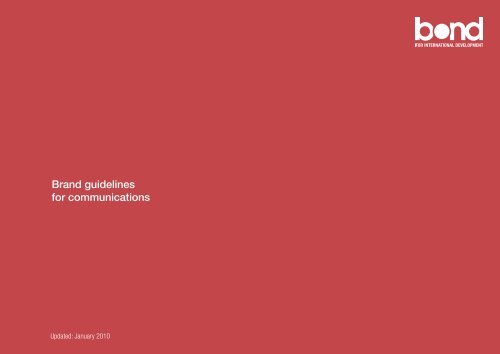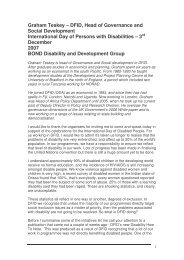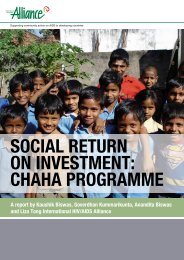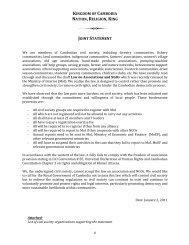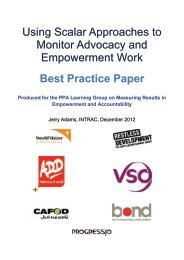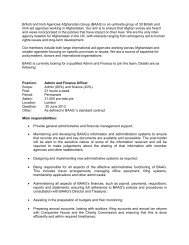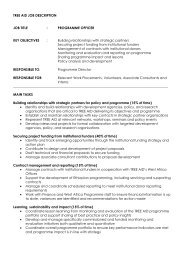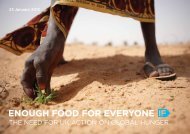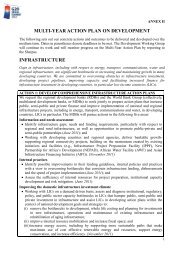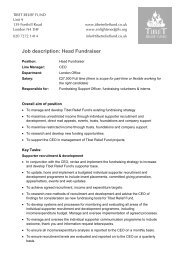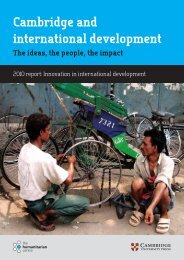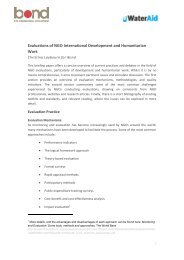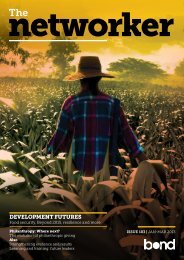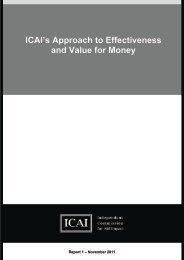Bond brand guidelines, updated January 2010
Bond brand guidelines, updated January 2010
Bond brand guidelines, updated January 2010
- No tags were found...
Create successful ePaper yourself
Turn your PDF publications into a flip-book with our unique Google optimized e-Paper software.
Brand <strong>guidelines</strong>for communicationsUpdated: <strong>January</strong> <strong>2010</strong>
<strong>Bond</strong> <strong>brand</strong> <strong>guidelines</strong>ContentsWelcome to the <strong>Bond</strong> <strong>brand</strong><strong>guidelines</strong>, which introduceyou to our new <strong>brand</strong>.Our <strong>guidelines</strong> are constantlygrowing and moving on. As wedevelop new sections andreview old ones, we will makesure we keep you up to date.1 Our <strong>brand</strong>1.1 Introduction1.2 What we do1.3 Our vision and purpose1.4 How we work1.5 Our personality1.6 Our tone of voice2 Identity elements2.1 Identity <strong>guidelines</strong>2.2 Our logo2.3 Our logo - variants2.4 Our logo - strapless2.5 Supporting logos2.6 Our logo - usage2.7 Our logo - exclusion zone2.8 Our logo - position2.9 Our logo - co-<strong>brand</strong>ing2.10 Our logo - size2.11 Our colours - primary2.12 Our colours - secondary2.13 Our typeface - primary2.14 Our typeface - secondary2.15 Our typographic style3 Our office communications3.1 Our stationery3.2 Master template3.3 Our email signature3.4 PowerPoint3.5 E-bulletins4 Our imagery4.1 Use of photographs5 Our website5.1 Our <strong>brand</strong> online6 The Networker6.1 The Networker guides7 Our events and exhibitions7.1 Our events materialsUpdated: <strong>January</strong> <strong>2010</strong>
1 Our <strong>brand</strong>
<strong>Bond</strong> <strong>brand</strong> <strong>guidelines</strong>IntroductionThe challenges of eradicating world poverty are so vast, complexand inter-related that those working in international developmentrecognise the need to collaborate for effective change andsolutions. As the membership body for UK NGOs working ininternational development, <strong>Bond</strong> is uniquely placed to bringpeople together to make this happen.We promote, support, represent and, on occasion, lead the workand interests of the UK international development sector. We dothis by creating opportunities for members to work, learn andshare together through the exchange of ideas, experience andinformation to strengthen the quality and effectiveness of thesector.Established in 1993, we now have over 350 memberorganisations ranging from large organisations with a world-widepresence to smaller, more specialist organisations working inspecific regions or with specific groups of people.Updated: <strong>January</strong> <strong>2010</strong>
<strong>Bond</strong> <strong>brand</strong> <strong>guidelines</strong>Our vision and purposeOur visionA world of justice and equality, free from poverty, wherehuman rights and the environment are respected.Our purposeTo be the uniting force for the strength, influence andeffectiveness of UK international development organisations.Updated: <strong>January</strong> <strong>2010</strong>
<strong>Bond</strong> <strong>brand</strong> <strong>guidelines</strong>How we workIn everything we do, we aim to:• Inspire• Challenge• LeadInspire• Staff of memberorganisations to get involvedin the network• Members to workcollaboratively and takeaction together• Members to share and learntogether to build the capacityof the sectorChallenge• Members to ask thedifficult questions• Members and others workingin international developmentto find new and creativesolutions to key sector issues• The UK Government andother decision-makers totake action on behalf ofthose living in poverty,inequality and injusticeLead• The collective conscience ofthe sector ‘from within’ andkeep the connection withour members• By bringing together differentvoices and expertise andamplifying them• Cross-sectorally on theissues that members can’ttackle on their ownUpdated: <strong>January</strong> <strong>2010</strong>
<strong>Bond</strong> <strong>brand</strong> <strong>guidelines</strong>Our personalityOur <strong>brand</strong> personality is bought to life by the words we use andhow we express ourselves.Our personality is how we would like our members and others inthe sector to describe us. It should be reflected in all ourcommunications, although not all of the elements will be presentat the same time, or in equal measure; it will depend on thecommunication and the audience. As well as being aboutcommunication, our personality is also about our attitude and theway we work and behave.Our personality is:• Confident – we have knowledge and expertise on key issues,but we listen to others and are not arrogant• Accessible – we are approachable and encourage feedbackand ideas from members on how we can better meet theirneeds and fulfill our purpose• Collaborative – we passionately believe in working together forchange. We provide a range of opportunities for members andothers to share their knowledge, opinions and ideas• Motivating – we inspire others to share our vision and purposeand to get involved in the issues that matter to them• Professional – we take our work seriously and are committedto meeting the needs of our membersUpdated: <strong>January</strong> <strong>2010</strong>
<strong>Bond</strong> <strong>brand</strong> <strong>guidelines</strong>Our tone of voiceOur tone of voice relates to how our <strong>brand</strong> feels to others, and howwe express ourselves verbally.We use simple, clear language that is accessible to an audience with abroad level of knowledge on sector issues but who might not beexperts in a particular area. We avoid jargon and over-complicatingwhat we are trying to say, and we do not use acronyms unless theyare absolutely necessary or an industry standard.We use the active, rather than the passive voice, to bring our copy tolife. We always try to use positive language to inspire and motivatemembers and others involved in international development to takeaction or understand more about a subject with which they might notbe familiar.Our tone of voice is:• Leading• Engaging• Confident• CoherentAlthough we speak with authority on certain issues, we are nevercondescending, take a superior tone or assume we have moreknowledge than others. Above all, we want to engage with currentand prospective members and our other key audiences through thelanguage that we use and the way we express ourselves.Language style guide...Our house language style guide shouldbe used in all our external writtencommunications to ensure consistency.It offers a practical guide to how weexpress ourselves and the style we usein our everyday writing. Whenever wewrite a piece of internal or external copyit must comply with the house style:M:\Guidelines and templatesUpdated: <strong>January</strong> <strong>2010</strong>
2 Identity elements
<strong>Bond</strong> <strong>brand</strong> <strong>guidelines</strong>Identity <strong>guidelines</strong>Our <strong>brand</strong> is much wider than simply our identity. It is thedistillation of what <strong>Bond</strong> is: the outward expression of our vision,our values, our expertise and our purpose. It distinguishes usfrom other organisations, reflects our distinctive personality andsignposts the direction in which we are moving.By following these <strong>guidelines</strong> wewill be stronger together.For further information about our <strong>brand</strong> orthe <strong>guidelines</strong>, please contact JemmaAshman, Communications and MarketingOfficer, at jashman@bond.org.ukThe <strong>Bond</strong> <strong>brand</strong> inspires loyalty and commitment from membersand other key stakeholders and provides the base from which wewill continue to strengthen the membership, build the capacity ofthe sector and influence decision makers in order to fulfill ourpurpose.These <strong>guidelines</strong> provide clear and practical rules forcommunicating the <strong>Bond</strong> <strong>brand</strong>. They are for all our internal andexternal communications and convey our <strong>brand</strong> essencethrough visual identity and written tone.Everyone involved with <strong>Bond</strong> needs to understand and followthese <strong>guidelines</strong>. They will help you when creating ourcommunications material. Whether you are administrating,writing, presenting or giving advice, your work affects the waypeople see us. Working together, we will build a consistent,authoritative and professional <strong>brand</strong>.Updated: <strong>January</strong> <strong>2010</strong>
<strong>Bond</strong> <strong>brand</strong> <strong>guidelines</strong>Our logoOur logo is a key aspect of our visual identity. It comprises threeelements: the logotype, the ‘o’ and the strapline. The circleformed within the letter ‘o’ is used to create a positive shapewhich reaches across the letters ‘b’ and ‘n’, symbolic of how<strong>Bond</strong> is a uniting force – our member organisations share a vision,and the network is where work for a shared purpose is joinedtogether. The ‘o’ could also represent the world. The overlappingwhite shape of the ‘o’ creates visual interest, a reason for a‘second glance’. The logo is the most visible element of ouridentity – a global signature across all<strong>Bond</strong> communications. It’s a guarantee of quality that unitesour membership.Because the logo is such a recognisable and highly visible <strong>brand</strong> asset, it isvital that it is always applied consistently and professionally wherever itappears, the integrity of the design of our logo must always be maintained.The size and relationship between the logotype, ‘o’ and strapline has beencarefully considered. The logo should ONLY be changed in scale and never inany other way. NEVER alter, approximate, redraw or distort the logo in anyway.Always use the original artwork and DO NOT attempt to recreate the <strong>Bond</strong>logo.All logo files are available from jashman@bond.org.ukThe <strong>Bond</strong> ‘o’The simple rules:• Don’t stretch it• Don’t re-colour it• Don’t separate the elements• Don’t outline it• Don’t add to it• Don’t reproportion it• Don’t re-draw it• Don’t add new coloursLogotypeStraplineOur logoUpdated: <strong>January</strong> <strong>2010</strong>
<strong>Bond</strong> <strong>brand</strong> <strong>guidelines</strong>Our logo – variantsOur logo is available in three colour formats, full colour,mono (black only) and white (reversed out).1 4-colour (CMYK) logo – use this wherever you can.The preferred logo is shown here in its CMYK (full-colour) printversion on a white background; the primary use where possible.1 4-colour2 Mono (black only) – use this only if you have to.Please only use this logo where only 1-colour print is available,for example in newsprint. Never use a black logo when yourcommunication is full-colour.3 White (reversed out) – use this only if you have to.This application should be used sparingly, for instances suchas, <strong>brand</strong> reminders (eg, pens and USB sticks), or where the logomay be required to appear white (reversed out) on a coloredbackground or image. Please ensure that it is always legible andcreates impact.2 MonoPlease refer to section 2.6 for futher information on using a white(reversed out) logo.The simple rules:• Always ensure you use thecorrect colour version foryour specific need• If in doubt, ask!3 WhiteUpdated: <strong>January</strong> <strong>2010</strong>
<strong>Bond</strong> <strong>brand</strong> <strong>guidelines</strong>Our logo – straplessWherever possible the logo should appear with our strapline‘For International Development’. It has been created to be ashort and memorable descriptor, that represents ourorganisation, it says what we do, what benefits we give ourmembers and what we stand for.1 4-colour (strapless)There may be times when it is not possible or practical to include thestrapline. These instances could include:• If the logo appears smaller than the minimum size• When the logo appears on the <strong>Bond</strong> website or ebulletin• On <strong>brand</strong> reminders• When reproduction quality affects legibility and impactWhen the logo is used without the strapline, the artwork must bechecked by <strong>Bond</strong> to ensure that the <strong>brand</strong> integrity is not compromised.2 Mono (strapless)The rules for using our strapless logo are exactly the same as thosefor the logo with the strapline, please read sections 2.3 and 2.6 forfurther information.The simple rules:• If legibility or impact areat risk, go strapless• If in doubt, ask!3 White (strapless)Updated: <strong>January</strong> <strong>2010</strong>
<strong>Bond</strong> <strong>brand</strong> <strong>guidelines</strong>Supporting logosIn addition to our main logo, there are two further variationsthat can be used to highlight that a specific project orcampaign has been supported by <strong>Bond</strong> or that anotherorganisation is a member of <strong>Bond</strong>.SUPPORTED BY‘Supported by’ logoOn occasion, <strong>Bond</strong> plays a supporting role, for example in organising an event orcampaign. In these situations, although we might not want to over-publicise ourinvolvement and take the spotlight away from others, we still want our contributionto be recognised.Using the ‘Supported by’ logo offers a subtle way for members and others working inthe sector to get a clear understanding of the range of activities that <strong>Bond</strong> is involvedin, whilst not detracting away from others who might be leading on the work.‘Members of’ logoThe ‘Member of’ logo is an easy and effective way to inspire member loyalty andcommitment to <strong>Bond</strong>, and to reinforce our essence of stronger together. It helpsmembers to feel part of <strong>Bond</strong> and instills a sense of pride. The logo does not meanthat the organisation has reached a <strong>Bond</strong>-endorsed quality mark or similar; it issimply a way for <strong>Bond</strong> members to identify themselves.Members must adhere to the bond <strong>brand</strong> <strong>guidelines</strong> when using the logo, notablysection 2.2, 2.7 and 2.10.Members can only display the logo on an appropriate page of their website. Thereshould also be a link from the logo to the <strong>Bond</strong> website (www.bond.org.uk). Allartwork must be checked by <strong>Bond</strong> so please email us the link to the page on yourwebsite where the <strong>Bond</strong> logo is placed: jashman@bond.org.ukIf members wish to display the logo elsewhere, they must contact <strong>Bond</strong>.1 Supporter logo2 Member logoMEMBER OFUpdated: <strong>January</strong> <strong>2010</strong>
<strong>Bond</strong> <strong>brand</strong> <strong>guidelines</strong>Our logo – usageCare must be taken to ensure our logo is used correctly andconsistently across all communications. Incorrect use of ourlogo compromises its integrity, value and effectiveness.XOur logo is strong and impactful, and should only appearminimally in any printed communication.The 4-colour logo should normally appear on a whitebackground and should never appear on any colouredbackgrounds or on top of photography as this compromisesits legibility (to check the position, please refer to section 2.8).XIn special circumstances the white logo can appear on top of an image orcolour. When placing our logo over a image, please ensure it has ampleclear space and does not obscure the image to provide maximum legibitlyand impact (see examples as featured right).When used in this way, the artwork must be checked by <strong>Bond</strong> to ensurethat the <strong>brand</strong> and legibility is not compromised.Don’t clash:Never put the logo onto backgroundcolours that will clash with the logo ordetract from our <strong>brand</strong>. Where possible,put the logo onto white.Updated: <strong>January</strong> <strong>2010</strong>X
<strong>Bond</strong> <strong>brand</strong> <strong>guidelines</strong>Our logo – exclusion zoneAn exclusion zone (the minimum unobstructed area around the<strong>Bond</strong> logo) has been developed to make sure that the logo issufficiently prominent and maintains its impact. This area mustnot contain any other graphic or typographic element. The zoneis calculated using the width of the ‘o’ from the word <strong>Bond</strong>. Thelogo should be surrounded by the space equivalent to at leastthe width of the one ‘o’.ExclusionZoneThere are no exceptions* to the exclusion zone rule – we mustrespect our logo by giving it prominence.*Exception note:The exclusion zone rules are different forelectronic media and <strong>brand</strong> reminders toallow our <strong>brand</strong> to be prominent withinthe space available.Updated: <strong>January</strong> <strong>2010</strong>
<strong>Bond</strong> <strong>brand</strong> <strong>guidelines</strong>Our logo – positionOur logo is best positioned at the top right-hand corner of adocument, but, this will depend on the piece you are producing,the design you are using and the medium. We simply ask thatwhen creating a communication for <strong>Bond</strong> you are sensible andensure that it looks clean and simple, has impact, and has plentyof white space around it.Top rightcornerThe logo should be positioned one ‘o’ across and down from theedge of the document.DL A4 DVD Television (widescreen 16.9)If you have to move it...There are special cases where the logocan appear somewhere else.• On the <strong>Bond</strong> website• Websites – the logo should always beplaced top left of the screen to allow forsmall screens.• On circular objects (eg DVDs). You canput the logo anywhere sensible oncircular objects.• In animated media (eg TV end frames,plasma screens, MMS). For thesecases, centre the logo within the screenfor the end frame.Updated: <strong>January</strong> <strong>2010</strong>
<strong>Bond</strong> <strong>brand</strong> <strong>guidelines</strong>Our logo – co-<strong>brand</strong>ingThere may be times when another or multiple partner logosneed to appear alongside the <strong>Bond</strong> logo.DominantWhen we are dominant we still follow the master<strong>brand</strong><strong>guidelines</strong> but we allow our partner <strong>brand</strong>s to appear in acarefully controlled environment.Where <strong>Bond</strong> is dominant:• Follow <strong>Bond</strong> master<strong>brand</strong> <strong>guidelines</strong> as before ensuringthat the logo is seen in the top right hand corner• Our partner is only allowed to use one logo to representtheir presence• We always prefer our partner logo to appear at thebottom. If this is not possible, top left is the alternative• The partner logo should always appear smaller than the<strong>Bond</strong> logo• The partner logo and the <strong>Bond</strong> logo should never beseen to be locked up – they should have space tobreathe• The partner logo should never obscure any <strong>Bond</strong> visualelements or create a cluttered feel• The <strong>Bond</strong> secondary colour palette must be used. See2.12• Arial, our default font, must be used. See 2.14This is to ensure consistency and that the <strong>brand</strong> is notcompromised.Updated: <strong>January</strong> <strong>2010</strong>EqualWhen we are an equal partner we need to allow bothparties to communicate their <strong>brand</strong> without creating adisjointed or confused look and feel.Where <strong>Bond</strong> is equal:• Always refer to the master<strong>brand</strong> <strong>guidelines</strong> for basic rulesabout the <strong>Bond</strong> <strong>brand</strong> identity. We will never break theserules• We must ensure that this communication remains simple,effective and powerful. This means that both parties willhave to remove clutter and peripheral <strong>brand</strong> elements• The partner logo should always appear equal to orsmaller than the <strong>Bond</strong> logo• Never spilt the communication in two. This may causeconflict between colours, typefaces and styles• We should always try and keep the <strong>Bond</strong> logo in the topright-hand corner. We always prefer our partner logo toappear at the bottom. If this is not possible the logoshould be placed in the top left hand corner• The partner logo and the <strong>Bond</strong> logo should never beseen to be locked up – they should have space tobreathe• If colour is used, the <strong>Bond</strong> secondary colour palette ispreferred. If this is not possible, other neutral colours,and not the corporate colours of the partnerorganisation, should be used. <strong>Bond</strong> must approve allcolours. See 2.12• Arial, our default font, must be used. This is a neutralfont that has wide-spread availability and compatibility.See 2.14The simple rules:• Follow these <strong>guidelines</strong> toensure consistency and thatthe <strong>brand</strong> is not compromised.
<strong>Bond</strong> <strong>brand</strong> <strong>guidelines</strong>Our logo – sizeThe <strong>Bond</strong> logo has been designed to represent our <strong>brand</strong>with the optimum legibility at all sizes. Always use our logoin one of the sizes shown below, depending on the size ofyour communication.Size of applicationMin. DL A5 A4 A3 A2 A120mm : Min.30mm : DL/A5Width of logo20mm • • • • ●• ●• •●30mm • • • • • • •40mm • • • • • • •60mm • • • • • • •90mm • • • • • • •120mm • • • • • • •40mm : A460mm : A3Minimum sizeA minimum size of 20mm wide hasbeen established for all printed material(this excludes <strong>brand</strong> reminders andweb). Applied any smaller, the logowould be difficult to see. If you reallyhave to make an exception, make surethat the logo is still clear and legible inthe media you’re using.90mm : A2Updated: <strong>January</strong> <strong>2010</strong>
<strong>Bond</strong> <strong>brand</strong> <strong>guidelines</strong>Our colours – primaryColour is an integral part of our <strong>brand</strong>. There are two primarycolours within our palette, which are <strong>Bond</strong> red and warm grey.The <strong>Bond</strong> red demonstrates our <strong>brand</strong> persona in a very strikingway, whilst the use of warm grey supports this, creating a visualrepresentation of our values and tone of voice.It is important not to over use the <strong>Bond</strong> red. It should bereserved for adding contrast. The logo should stand out, nothave to compete with the red elsewhere.The primary colour palette should never be tinted withoutconsulting <strong>Bond</strong>.<strong>Bond</strong> RedProcessC0 M87 Y70 K7RGBR223 G67 B70Web# df4346Warm GreyProcessC30 M25 Y40 K20RGBR152 G148 B130Web# 989482Important...The colours must always be reproducedto conform with one of the specificationsindicated here:• CMYK for four colour printing.• RGB for on-screen or multi-mediaapplications (TV, video etc).• WEB for online (website)Updated: <strong>January</strong> <strong>2010</strong>
<strong>Bond</strong> <strong>brand</strong> <strong>guidelines</strong>Our colours – secondaryThe secondary palette of five colours provide a bright and flexiblebasis for creating designs for <strong>Bond</strong>’s promotional and publicationwork. The secondary palette should not be used in place of ourprimary colours, but rather to add the required diversity tocommunication items.We’re specific about the secondary colours because we need to be consistent– if we can’t use <strong>Bond</strong> red and warm grey, it doesn’t mean we use any othercolour we fancy. The secondary colours shown here have all been chosen tosupport our primary colours properly, never detracting from our <strong>brand</strong>.TintsThe <strong>Bond</strong> palette has been designed tobe bright and bold and in mostinstances the palette should be used atfull strength (100%). However, theremay be times when tints are needed toachieve a specific result. In this instancea tint of 20% can be used to supportthe 100% value. Tints should only everappear alongside the 100% value.Never create designs soley using tints.20% 20% 20% 20% 20%<strong>Bond</strong> Yellow<strong>Bond</strong> Orange<strong>Bond</strong> Purple<strong>Bond</strong> Green<strong>Bond</strong> BlueProcessC0 M25 Y100 K0ProcessC0 M58 Y100 K0ProcessC10 M75 Y0 K34ProcessC70 M0 Y72 K0ProcessC80 M65 Y0 K0RGBR255 G194 B14RGBR246 G134 B31RGBR157 G69 B120RGBR71 G185 B120RGBR71 G100 B175Web# ffc20eWeb# f6861fWeb# 9d4578Web# 47b978Web# 4764afUpdated: <strong>January</strong> <strong>2010</strong>
<strong>Bond</strong> <strong>brand</strong> <strong>guidelines</strong>Our typeface – primaryOur primary typeface used for all professionally printedcommunication materials is the Helvetica Neue family. Thistypeface has been chosen specifically to work in harmony withour new logo.A number of weights are available, allowing a full range ofcreative expression and to enable a versatile and effectivetypographic style for our visual identity.For in-house publications, see our secondary typeface<strong>guidelines</strong> in section 2.14.The benefits of Helvetica Neue...This is our primary typeface because it is:• universally accepted• legible in all sizes and weights• space-efficient• flexible• contemporary45 Helvetica Neue LightabcdefghijklmnopqrstuvwxyzABCDEFGHIJKLMNOPQRSTUVWXYZ1234567890 £&@?!/+(.,:;)55 Helvetica RomanabcdefghijklmnopqrstuvwxyzABCDEFGHIJKLMNOPQRSTUVWXYZ1234567890 £&@?!/+(.,:;)65 Helvetica MediumabcdefghijklmnopqrstuvwxyzABCDEFGHIJKLMNOPQRSTUVWXYZ1234567890 £&@?!/+(.,:;)75 Helvetica BoldabcdefghijklmnopqrstuvwxyzABCDEFGHIJKLMNOPQRSTUVWXYZ1234567890 £&@?!/+(.,:;)95 Helvetica BlackabcdefghijklmnopqrstuvwxyzABCDEFGHIJKLMNOPQRSTUVWXYZ1234567890 £&@?!/+(.,:;)Updated: <strong>January</strong> <strong>2010</strong>
<strong>Bond</strong> <strong>brand</strong> <strong>guidelines</strong>Our typeface – secondaryThere will be times when using the primary font will not bepossible – for example, sending a digital document tosomeone outside the company who does not have the primaryfont, and you are not able to save it as a PDF. For this reason,we have selected a default font to help maintain a sense ofvisual consistency across the entire company.Arial has been selected as the default font based on its wide-spreadavailability and compatibility.Please remember that all of the same design principles apply when usingArial, and that we encourage you to use the primary font whenever possible.Please do not use any other fonts as they will not work withour <strong>brand</strong>.ArialabcdefghijklmnopqrstuvwxyzABCDEFGHIJKLMNOPQRSTUVWXYZ1234567890 £&@?!/+(.,:;)Arial BoldabcdefghijklmnopqrstuvwxyzABCDEFGHIJKLMNOPQRSTUVWXYZ1234567890 £&@?!/+(.,:;)Arial ItalicabcdefghijklmnopqrstuvwxyzABCDEFGHIJKLMNOPQRSTUVWXYZ1234567890 £&@?!/+(.,:;)Secondary usage...Arial has been chosen exclusively foruse in electronic applications such asMicrosoft® Word®, PowerPoint®,Excel®, Outlook®, etc...Online usage...For web pages, we use Verdana.VerdanaabcdefghijklmnopqrstuvwxyzABCDEFGHIJKLMNOPQRSTUVWXYZ1234567890 £&@?!/+(.,:;)Updated: <strong>January</strong> <strong>2010</strong>
<strong>Bond</strong> <strong>brand</strong> <strong>guidelines</strong>Our typographic styleTypography is another vital element of creating a distinct andrecognisable <strong>brand</strong>. Our typeface is friendly and approachable,while being confident and clear. By using our <strong>brand</strong> typefaceand controlling how we use it, it can add to the visualdistinctiveness of our <strong>brand</strong>.Be careful with emphasisTo emphasise type in a headline or secondary copy, use a different colour,or a bolder type weight. However, don’t scatter bold or different coloursthrough body copy – it disturbs the reading process and irritates thereader.Get the spacing rightTo ensure a consistent appearance of our <strong>brand</strong> in all our communicationsand marketing materials, it’s important that we get the leading andtracking right and try to avoid extreme spacing.• For body copy the leading should ideally be between 110% and 120%of the typesize.• For headlines the ideal leading is between 100 and 115% of the typesize• Avoid tracking when using body copy.• Headings and large text should be tracked to -5.Body copy line lengths should not exceed 80 characters.Body copy should never be set below 9pt.The simple rule is to keep typography clear, simple and strong.Updated: <strong>January</strong> <strong>2010</strong>Please don’t:• Use any other typeface• Attempt to re-cut thetypeface• Use too many weights withina document – one to two isrecommended• Use too many type sizes – asit creates confusion• Use too many methods ofhighlighting – it doesn’t needto be bigger, bolder and adifferent colour• Use the underline tool as ahighlight device
3 Our office communications
<strong>Bond</strong> <strong>brand</strong> <strong>guidelines</strong>Our stationeryStationery and paper stocks may seem everyday, but they arean important part of our <strong>brand</strong>. They help to make us feel likeone organisation, and present a united, consistent face to ourmembers and stakeholders as well as our staff. So it isimportant that we use the templates provided and the paperstocks we’ve specified.For stationery, our logo is consistently positioned on the right-hand side ofthe materials. We give the logo impact by keeping the area around it asclear as possible. This position gives the logo hierarchy, strength, andimpact. There are also practical reasons why we use it, for example,documents are usually stapled on the top left hand corner, which wouldobscure the logo if it was in this position. Also, people tend to flick throughdocuments from the right hand side of the page so if our logo is on the topright hand side, it will be visible more often.Our stationery includes:LetterheadContinuation paperBusiness cardsCompliments slipsIn order to maintain consistency in print production, a range of specificpaper stock has been recommended. Typically, eco-friendly paper is thepreferred paper. We recommend using Revive 100 Uncoated. Forspecification details please visit:www.roberthorne.co.uk/products/revive-100-uncoated-fscUpdated: <strong>January</strong> <strong>2010</strong>
<strong>Bond</strong> <strong>brand</strong> <strong>guidelines</strong>Master templateA master template has been created in Microsoft Word forinternal usage. The template can be adapted to suit individualneeds, such as meeting agendas, minutes, attendee lists,reports, and board papers.All templates can be found at: M:\Guidelines and templatesThe template has been designed to be user-friendly and flexible. Pleasemake sure that you use the <strong>Bond</strong> style sheets (i.e. <strong>Bond</strong> Body, <strong>Bond</strong>Heading etc) and our approved colour palette when creating charts anddiagrams as these have been set to adhere to our <strong>guidelines</strong>.You can also create your own templates or <strong>brand</strong>ed documents by usingthe logo and choosing the <strong>Bond</strong> style sheet from the drop down menu.There are also electronic templates for letterhead, continuation paper andfax.If you have any questions please email; jashman@bond.org.ukUpdated: <strong>January</strong> <strong>2010</strong>
<strong>Bond</strong> <strong>brand</strong> <strong>guidelines</strong>Our email signatureIt is important that we use a consistent email signature, so hereis the structure:Jemma AshmanCommunications and Marketing Officerjashman@bond.org.uk+44 (0)20 7520 0256<strong>Bond</strong> • Regent’s Wharf • 8 All Saints Street • London • N1 9RL • United Kingdom+44 (0)20 7837 8344 • bond@bond.org.uk • bond.org.ukRegistered Charity No. 1068839. Company Registration No. 3395681 (Englandand Wales)Read our e-communications disclaimerThe signature uses the two <strong>Bond</strong> primary colours. The name of the personshould be in the <strong>Bond</strong> red and the rest of the details should be in the warmgrey. Please include all the details shown.Please use the signature in all your external communications, including toBoard members.Please note: we do not use www in front of our web address in any of ourcommunications.Updated: <strong>January</strong> <strong>2010</strong>
<strong>Bond</strong> <strong>brand</strong> <strong>guidelines</strong>PowerPointWe have created a PowerPoint template for internal use.As our PowerPoint presentations are sometimes used outside theorganisation where our font may not be easily available, we use Arial as thefont for PowerPoint.The logo is positioned in the top right corner. The logoalways appears on the title slide and the final slide.Please make sure you use our approved colour palettefor PowerPoint charts and diagrams.The template is available from:M:\Guidelines and templates\TemplatesUpdated: <strong>January</strong> <strong>2010</strong>
<strong>Bond</strong> <strong>brand</strong> <strong>guidelines</strong>E-bulletinsAll our e-bulletins have a banner header that reflects the <strong>Bond</strong><strong>brand</strong> and take their style from the website.The main body of the e-bulletin is on the left hand side of the and there isspace for images to illustrate the items. The right hand column containslinks to priority pages on the website.Each e-bulletin uses one of colours from the <strong>Bond</strong> secondary colour palette(or an acceptable alternative agreed by the Communications and MarketingOfficer).The ‘From’ field and subject line should follow this structure:From: <strong>Bond</strong> [name of team or work area if appropriate]For example, <strong>Bond</strong> learning and trainingSubject: [Name of the e-bulletin]: [month/year]For example, Your Network: <strong>January</strong> <strong>2010</strong>Verdana is the default font.Always refer to the house style guide and <strong>brand</strong> <strong>guidelines</strong> when producingyour e-bulletin: M:\Guidelines and templatesUpdated: <strong>January</strong> <strong>2010</strong>
4 Our imagery
<strong>Bond</strong> <strong>brand</strong> <strong>guidelines</strong>Use of photographsWe adhere to the CONCORD <strong>guidelines</strong> on photography.The guiding principles are:Choices of images / messages will be made based on the paramount principles of:• Respect for the dignity of the people concerned• Belief in the equality of all people• Acceptance of the need to promote fairness, solidarity and justiceAccordingly in all our communications and where practical and reasonable withinthe need to reflect reality, we strive to:• Choose images and related messages based on values of respect equality,solidarity and justice• Truthfully represent any image or depicted situation both in its immediate and in itswider context so as to improve public understanding of the realities andcomplexities of development• Avoid images and messages that potentially stereotype, sensationalise ordiscriminate against people, situations or places• Conform to the highest standards in relation to human rights and protection ofthe vulnerable people• Conform to the highest standards in relation to children's rights according to theConvention on the Rights of the Child (CRC), as children are the subjects mostfrequently portrayed<strong>Bond</strong> prefers to use images of people involved in an action, rather than passiveimages that depict them as victims. Where appropriate, the images should bepositive and empowering. We prefer a ‘reportage’ style rather than a posed or setupphotos, and we don’t tend to use images where people are looking directly atthe camera.Always include a caption and photographer credit where appropriate.Updated: <strong>January</strong> <strong>2010</strong>
5 Our website
<strong>Bond</strong> <strong>brand</strong> <strong>guidelines</strong>Our <strong>brand</strong> onlineThis section is designed to give you broad creative guidance onour web site.Like all communications, our online <strong>brand</strong> must be consistent.When writing for the website, please use the house style guide and followthe writing for the web <strong>guidelines</strong>. Together, they will make sure that thecontent is consistent.Although these documents cover all aspects of how we write things like thedate and time at <strong>Bond</strong>, it is also important that web content reflects the<strong>Bond</strong> personality and tone of voice. This brings the <strong>brand</strong> to life and is oneof the cornerstones of our <strong>brand</strong> identity – see sections 1.5 and 1.6 for moreinformation.Colour on the website - <strong>Bond</strong> uses Beekeeper to update most of thewebsite content. Beekeeper makes the whole colour spectrum available tousers. However, the <strong>Bond</strong> website should only include the <strong>Bond</strong> primary orsecondary colour palette (see section 2.11 and 2.12).Using block colour, for instance to highlight text, is not allowed because itmakes the page look messy and inconsistent; use bold if you want to makecontent stand out. If you do want to use additional colour, please use thecolour codes detailed in 2.11 and 2.12 and confirm with theCommunications and Marketing Officer.When using colour, always check for accessibility, for example, white text ona <strong>Bond</strong> yellow background does not meet accessibility standards. Ask if youare not sure.Updated: <strong>January</strong> <strong>2010</strong>
6 The Networker
<strong>Bond</strong> <strong>brand</strong> <strong>guidelines</strong>The Networker guidesThe Networker is a bi-monthly publication that aims to provideup to date information and opinion on key development issues toa specialist audience of development practitioners,commentators and decision makers.Neo, our design agency, ensures that The Networker is visually on <strong>brand</strong>.It is up to the editor to make sure that it adheres to the <strong>Bond</strong> house styleandthe contributors to ensure that their article meets the purpose of TheNetworker:“To showcase the <strong>Bond</strong> network by highlighting key issues, emergingdebates, news and opportunities in the UK international development sectorwith the aim of engaging directors and other senior figures”. It seeks toreflect the leadership role of <strong>Bond</strong> and to reinforce the <strong>Bond</strong> <strong>brand</strong> byreflecting our personality and tone of voice.The Networker is sent to:• <strong>Bond</strong> director and <strong>Bond</strong> contact• UK, Europe and international NGO networks• A selected range of decision makers - including UKGovernment, NGO networks, think tanks and academicsThe content of articles should reinforce the value of <strong>Bond</strong>. Where possiblethey should be used to underpin what we do (section 1.2) and how we work(section 1.4) and should seek to actively engage with <strong>Bond</strong> members andother stakeholders.Updated: <strong>January</strong> <strong>2010</strong>
7 Our events and meetings
<strong>Bond</strong> <strong>brand</strong> <strong>guidelines</strong>Events materialsIn this section, you will find the overall principles for using ouridentity elements in events, for example, at <strong>Bond</strong> trainingcourses, new members meetings, chairs meetings, groupmeetings and launch events.Branded materials are available and should be used where possible toreinforce the <strong>brand</strong>. This includes:• Pull up banners• Branded badges – available from the Membership andCommunications Administrator• PowerPoint template• Agenda and delegate list templates• Handouts should include the <strong>Bond</strong> logo in the top right corner• <strong>Bond</strong> publications: The Networker, annual review, membershipleaflet, learning and training brochure where appropriateSee section 2.5 for use of supporting logos and 2.9 for co-<strong>brand</strong>ing<strong>guidelines</strong>.Updated: <strong>January</strong> <strong>2010</strong>
Regent’s Wharf · 8 All Saints Street · London · N1 9RL · United Kingdom+44 (0)20 7837 8344 · bond@bond.org.uk · bond.org.uk


